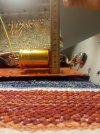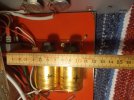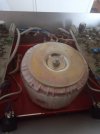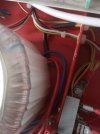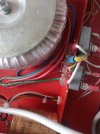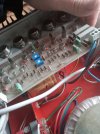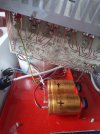The discussion maximum value of new electrolytes. I'm not getting into that. You with more experience and knowledge can discuss that.In practical terms, the space provides physical limitations, see photos. The electrolytes are screwed on (I guess I can, I'll have to remove the black screw and check).
As can be seen in the pictures, there is still some leeway. If new holes need to be screwed into the plate they are in, I will do it.
Two electrolytes (or it is called electrolytic capacitors) at each channel now .. Could four smaller type 50V 4700UF per channel be something (if there is physical space)? I googled and that particular combination seems to be common among electrolytes.In any case, I have to check it out. Then calm in the storm, I am inexperienced but not really that stupid that I do this entirely myself. I take the amplifier to my friend who has experience of changing electronics in amplifiers. So we will change the electrolytes. He was the one who made this change:
(not mine in the picture, same modell) Anyone have experience with, know anything about a vintage power amplifier Fostex 600? https://www.hifiengine.com/manual_library/fostex/600.shtml Got it very cheap this summer. It's right with my friend for a recap operation now. I'll see how it turns...

audiosciencereview.com
We'll see what happens. First we measure it well and see what it looks like on the occiloscope. I actually do not know what kind of measuring equipment he has, if he can measure distortion levels for example. I can check it with him.
He probably puts some dummy load in there and sees when it clipps. Maybe if he can see square waves. I actually do not know because I have not engaged in such measuring instruments myself. He has a small hobby workshop with various things, so it will be good.




